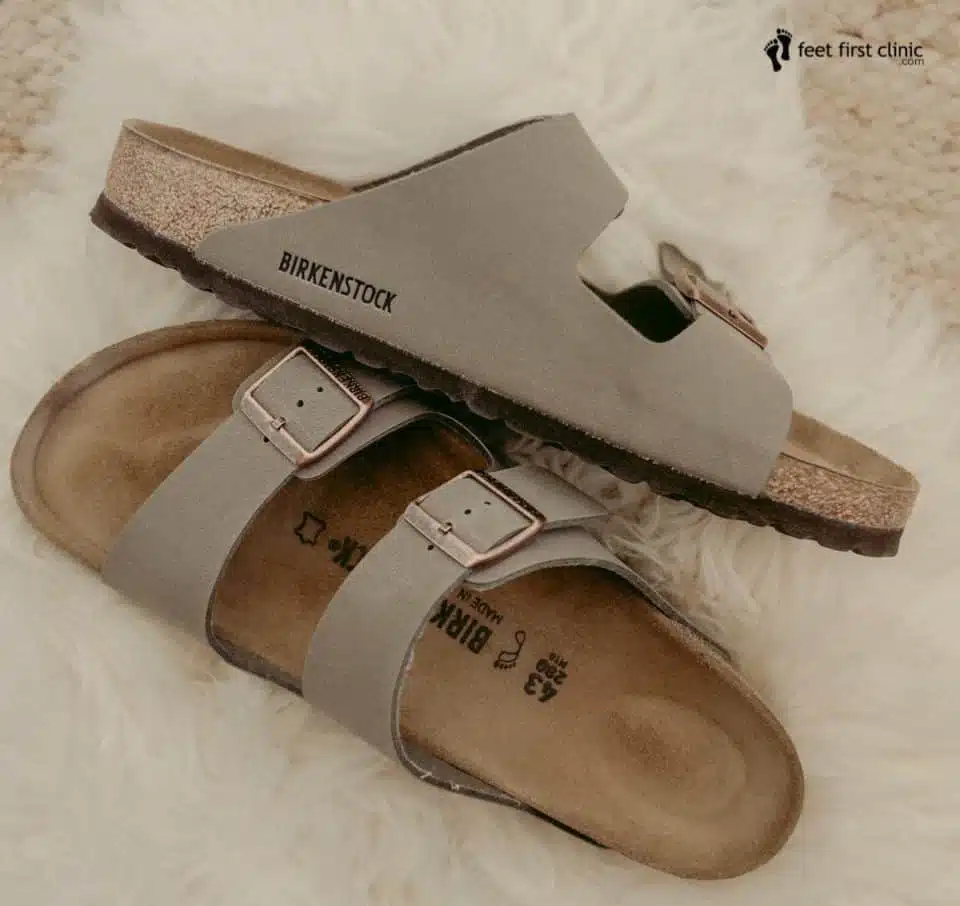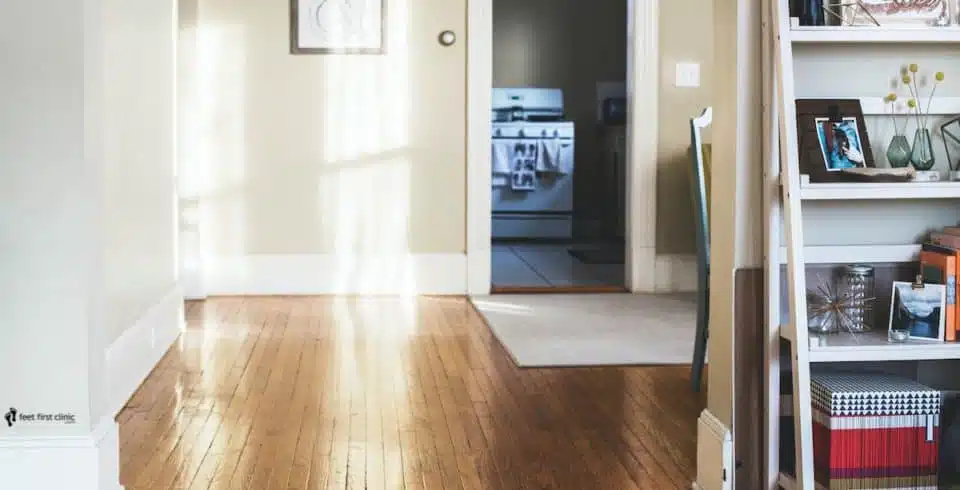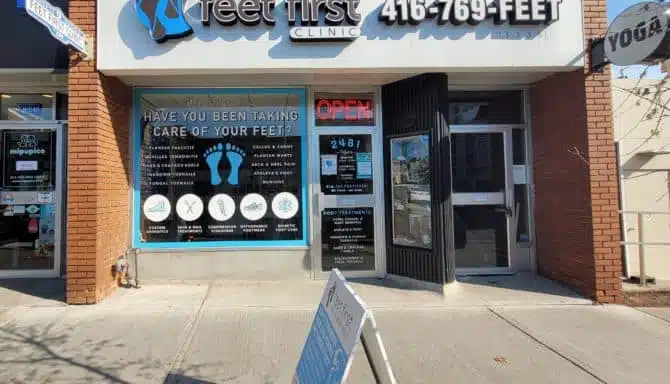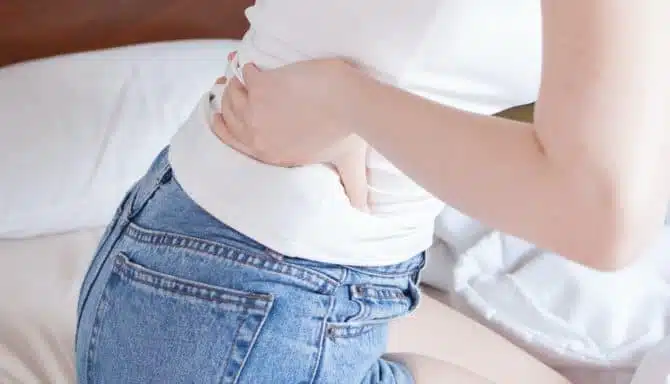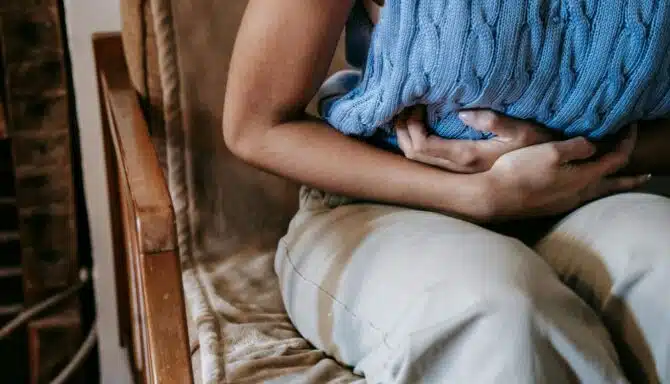There’s more to footwear than what you wear outdoors.
We spend much of our time in our homes – especially these days with many of us working remotely. A cardinal rule in many cultures is for guests to take off their shoes when in another person’s home. But what do we do in our own home? Does it make sense to wear indoor shoes in the house?
There are definitely certain benefits to wearing indoor shoes, whether it’s for a specific purpose, personal preference, or simply habit. On the flip side, some may have their reservations about it and may prefer to be more natural in the house by going barefoot (or in socks).
Ultimately, the choice is a personal one, and benefits/drawbacks vary. Cases can be made for both wearing and not wearing indoor shoes at home. We’ll break down the pros and cons for each so you can see whether the added support and protection of indoor shoes at home may benefit you.
The case for wearing indoor shoes at home
There are a number of benefits to wearing shoes indoors. The primary three at home include:
- Injury prevention
- Safety
- Comfort
We’ll discuss these more below:
1. Injury prevention
First and foremost, there are a number of foot conditions and injuries that you may be able to prevent – or limit the effects of – by wearing indoor shoes at home. The support, shock absorption and cushioning provided by indoor shoes help these conditions by reducing stress, strain and pressure on your feet and lower limbs when you move. Some conditions that may especially benefit from indoor shoes include:
- Plantar fasciitis: Indoor shoes are incredibly helpful for plantar fasciitis. This is a painful condition where the band of fibrous tissue at the bottom of your foot (called the “plantar fascia”) becomes inflamed. It is one of the most common causes of heel pain. Walking barefoot on hard surfaces for long periods can aggravate or contribute to plantar fasciitis due to the lack of support and excessive pressure this places on the plantar fascia. That’s why foot specialists often recommend that people with plantar fasciitis wear indoor shoes with strong arch and heel support, like the Birkenstock Arizona or the Mephisto Hester.
- Osteoarthritis: Osteoarthritis is a degenerative form of arthritis in which the cartilage between the joints in your body breaks down. It is often caused by the “wear and tear” of our joints over time. People with osteoarthritis often have very sensitive feet and may find relief from the cushioning of a good shoe.
- Rheumatoid Arthritis: This form of arthritis involves chronic inflammation of the joints, which ultimately leads to pain, swelling and joint damage. Similar to osteoarthritis, the tiny joints in our feet are commonly affected. As with osteoarthritis, arthritic feet are very sensitive and benefit from cushioning, shock absorption and anything supportive that eases the burden on the joints and muscles in the feet.
- Bunions: A Bunion (also known as “hallux valgus”) is a deformity affecting the joint that connects the big toe to the foot ( the “first metatarsophalangeal joint” – or “MTP” joint).
- Hammertoes: A hammertoe is a toe deformity in which the middle joint in the toe bends abnormally, causing the toe to point downward on an angle like a claw or hammer. It occurs in the four smallest toes of the foot, most commonly the second toe.
- Posterior tibial tendonitis (also known as shin splints): Shin splints is a term generally used for any sort of lower limb pain associated with the tibia, the large bone in the front of your leg. Medial tibial stress syndrome is the proper term for the condition.
- Heel spur: This is a bony protrusion or growth from the underside of the heel bone that forms over time due to repetitive muscular and ligament strain from activities such as walking, running, and jumping. It is often associated with plantar fasciitis.
- Flat feet: A collapsed arch with much of your sole in contact with the ground. This is relative to a regular arch, which is when about half of your arch is in contact with the ground. Flat feet require strong, consistent arch support in order to keep the muscles and joints in the feet properly supported and reduce strain.
- Athlete’s foot: Athlete’s foot is a contagious fungal infection that can be spread via floors, towels, or clothing. Wearing shoes indoors (if you’re sharing an apartment, or common space) can help keep your feet off the floor where the bacteria and fungus may live. Just make sure your footwear is breathable and has moisture-wicking or antimicrobial properties, because fungus and bacteria love moisture.
2. Safety
Safety is a very real concern in the home. Falling, stubbed toes, sprains, and bruises are all common at-home injuries.
In fact, according to the Seniors’ Falls in Canada: Second Report issued by the government of Canada, falls remain the leading cause of injury-related hospitalizations among Canadian seniors. Between 20% and 30% of seniors fall each year. The report states:
“Falls can lead to negative mental health outcomes such as fear of falling, loss of autonomy and greater isolation, confusion, immobilization, and depression. In addition to the negative physical and mental health consequences of falling, there are significant associated financial costs, estimated at $2 billion annually, a value 3.7 times greater than that for younger adults.”
The report also states that footwear designs may improve postural stability through, for example, balance-enhancing insoles. Although the report focuses on seniors, the same remains true for the remainder of the population. Wearing supportive shoes can help you stay balanced and on your feet.
Although falls may be less prevalent in younger generations, anyone can stub their toes, sprain an ankle, or bruise. Closed-toe footwear can add a layer of protection against such mishaps. This protection is essential for people with diabetes. Even a small cut or scrape can cause serious complications when you have diabetes. That’s why indoor footwear is a highly recommended safety precaution for diabetic feet.
Products like NAOT sandals and Birkenstocks give you the best of both worlds: open-toed shoes that let your feet breathe, combined with adequate support. Birkenstocks feature shock-absorbing EVA material underfoot, a cork footbed that molds to your feet, and a footbed liner that keeps your feet dry. Birkenstock offers both sandals as well as closed-toe shoes and clogs depending on your preference.
Meanwhile, Apex‘s Moore Balance Shoe (MBS) is the first-ever footwear scientifically designed to reduce one’s risk of falling.
3. Comfort
Finally, indoor shoes are great for comfort. Are your feet always cold? Indoor shoes can also provide warmth and comfort as temperatures drop between fall and spring.
Anodyne‘s slippers, for example, feature a premium suede upper, soft faux-shearling lining, a supportive foam footbed, and a protective toe box and heel counter. These products are designed with the diabetic end-user in mind. Not only is warmth a factor, but the support provided by indoor shoes can help reduce pain and discomfort for those who find walking barefoot uncomfortable.
The case against wearing indoor shoes at home
Now for the flip side. To play devil’s advocate, there are three primary reasons not to wear shoes indoors:
- Personal choice
- The wrong shoes
- Improper care
1. Personal choice
Some people prefer not to wear shoes inside because it means you essentially wear footwear 24/7. Some claim this can impede the “natural” movement of our feet. Those who prefer minimalist outdoor shoes, for example, may believe that excessive use of footwear can contribute to further muscle imbalance.
There may also be the personal preference of simply being outside of shoes after a long day of work. If you wear shoes all day or are on your feet for long hours, unwinding sans shoes may be preferable. In these cases, the choice of no shoes may outweigh the potential benefits of indoor shoes at home.
2. The wrong shoes
By wearing indoor shoes at home, you may simply choose the wrong pair. Features of footwear including soles that are too thick, a tread that is too smooth, and shoes with heels that are too high and/or too narrow are linked to falling risk.
Switching back and forth between indoor and outdoor shoes can add in another element. For example, wet footwear can lead to slips on smooth indoor flooring. Thus, avoid wearing indoor shoes outside, and getting lazy, and not swapping them out when you go inside. Wearing your indoor shoes outside, and then bringing them indoors poses additional risks. For example, you may be exposed to additional germs (picture a sidewalk), debris, and smells.
3. Improper care
With any type of footwear, you want to take good care of your shoes. Make sure you swap out any footwear you use consistently, especially if you wear them without socks. Watch for signs of smell, holes, or worn treads.
The longer you wear your footwear over the course of a day, the more prone you are to moisture-buildup. This can lead to unwanted foot conditions, like Athlete’s foot and toenail fungus, which thrive in dark, moist environments. Of course, you can offset this risk by wearing breathable shoes with moisture-wicking and anti-microbial materials. Skin cells from your feet also shed into any footwear you wear, so letting them sit can also be helpful.
Your footwear solutions live here!
We have all your solution under one roof. Our on-site shoe store provides patients with therapeutic tools and resources including orthopedic footwear, insoles, medical devices, and over-the-counter solutions. Open six days a week.
Call or Book Today and we’ll have you in asap! Open 6 days a week, we’re happy to help and solve all your concerns any day at your convenience!
Call us at 416-769-3338 or Book Your Assessment Today!


